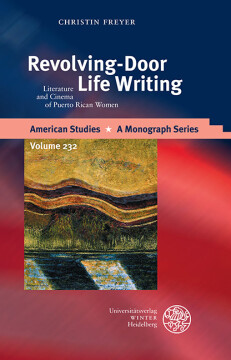
BUCH
Revolving-Door Life Writing
Literature and Cinema of Puerto Rican Women
American Studies – A Monograph Series, Bd. 232
2013
Zusätzliche Informationen
Bibliografische Daten
Abstract
‘Revolving-Door Life Writing’ is about selected Puerto Rican female (im)migrant authors and filmmakers on the East Coast of the United States. The focus of this study lies on the hybrid and partly transnational cultural identities of these life writers. Since Nuyorican and “NuRican” life writing undermines the given context of the (neo-)colonial status, decisive attempts at decolonisation take place. The authors use the rather subversive strategy of jaibaría, a Puerto Rican folk tactic; the filmmakers are more overt with their tools of directness voiced in confrontation and provocation. Combining psychology, sociology and postcolonial studies in an interdisciplinary approach within the realm of Transnational American Studies, this work reveals “living in-between” as a difficult yet decisive experience leading to a conscious and active support of a shared humanity.
Inhaltsverzeichnis
| Zwischenüberschrift | Seite | Aktion | Preis |
|---|---|---|---|
| Table of Contents | VII | ||
| Acknowledgements | XI | ||
| 1 Introduction | 1 | ||
| 2 Puerto Rican History and Migration | 9 | ||
| 2.1 “The Oldest Colony of the Modern Worldˮ... | 12 | ||
| 2.2 “Casi la misma cantidad... ˮ | 21 | ||
| 3 The Puerto Rican Migrant in New York City and beyond: Hybrid, Transnational Identities and Life Writing Approaches | 31 | ||
| 3.1 Hybridity Puerto Rican Style: The Nuyoricans and beyond | 35 | ||
| 3.2 Transnationalism and Related Concepts: Towards the NuRican | 42 | ||
| 3.3 Postcolonial Identities, Jaibaría, Directness and Life Writing | 48 | ||
| 3.4 Selected Writers and Filmmakers and Their Position in New York City Puerto Rican Literary and Cinematic Production | 58 | ||
| 4 Revolving-Door Life Writing: Hybrid, Transnational Identities | 67 | ||
| 4.1 Nuyorican Identities | 67 | ||
| 4.1.1 Towards an Integrated Hybrid Identity: Esmeralda Santiagoʼs "When I Was Puerto Rican" (1993) and "Almost a Woman" (1998) | 68 | ||
| 4.1.2 Challenges Facing the Hybrid: Nicholasa Mohrʼs "Nilda" (1973) | 88 | ||
| 4.1.3 Multi-Ethnic Hybrid Identity: Marta Moreno Vegaʼs "When the Spirits Dance Mambo: Growing up Nuyorican in El Barrio" (2004) | 106 | ||
| 4.2 NuRican Identities | 125 | ||
| 4.2.1 Support for the Transnational Hybrid: Judith Ortiz Coferʼs "Silent Dancing: A Partial Remembrance of a Puerto Rican Childhood" (1990) | 126 | ||
| 4.2.2 Reimagining of the Transnational Hybridʼs Cultural Identity: Frances Negrón-Muntanerʼs "Brincando el Charco: Portrait of a Puerto Rican" (1994) | 147 | ||
| 4.2.3 Non-Belonging, Alienation and Fragmentation of the Transnational Hybrid: Judith Escalonaʼs "The Krutch" (2004) | 170 | ||
| 5 Conclusion | 193 | ||
| Works Cited | 199 | ||
| Appendix | 223 | ||
| Tables | 223 | ||
| Table 1 - Puerto Rican Population of New York City and the United States, 1900-2010 | 223 | ||
| Table 2 - Puerto Ricansʼ Residence, Selected Cities and New York City, 1950-2000 | 225 | ||
| Table 3 - Puerto Rico Status Plebiscites 1967, 1993 and 1998 | 226 | ||
| Table 4 - Hispanic/Latino Population of the United States, 1970-2008 | 227 | ||
| Table 5 - Diversification of Latino Population in the United States, 2000 Census and 2008 Estimate | 228 | ||
| Table 6 - Hispanic Population in the United States: 1970 to 2050 | 230 | ||
| Table 7 - Outmigrants from New York City by Destination, 1995-2000 | 231 | ||
| Table 8 - Puerto Rican Literature in New York City and beyond | 231 | ||
| Table 9 - Puerto Rican Film in New York City | 236 | ||
| Figures | 242 | ||
| Fig. 1. Emigration from Puerto Rico, 1900-2000 | 242 | ||
| Fig. 2. Return Migration to Puerto Rico, 1960-2000 | 243 | ||
| Fig. 3. Varieties of Groups in Plural Societies | 244 | ||
| Fig. 4. Acculturation Strategies Framework | 244 | ||
| Fig. 5. A Framework for Understanding Acculturation | 245 | ||
| Fig. 6. Acculturation Strategies, Degree of Ethnic Identity Retention and Cultural Identity | 245 | ||
| Interviews | 246 | ||
| Personal Interview with Nicholasa Mohr – 08 May 2008 | 246 | ||
| Telephone Interview with Marta Moreno Vega – 08 May 2008 | 256 | ||
| Personal Interview with Judith Escalona – 03 May 2008 | 260 |


 Publishing Platform by CloudPublish
Publishing Platform by CloudPublish